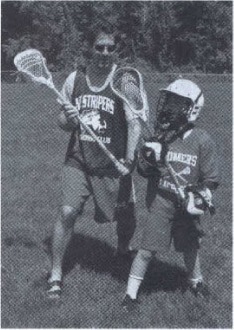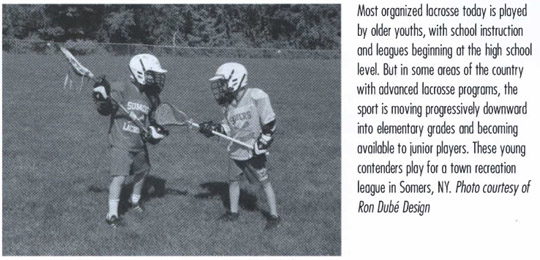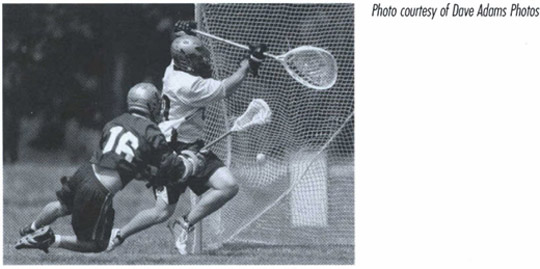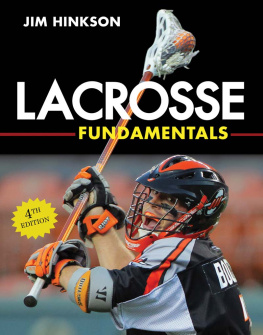
ACKNOWLEDGMENTS
I would like to thank the following people who helped in the creation of this book:
Graphic artist and photographer Ron Dub, for donating his time and the patience he showed working with our young player models, Sean Wagner, Tim Fazzinga, and Kevin Doherty. Photographer Dave Adams, whose live-action game photos bring a level of excitement to these pages. The Lyons Press, for all their behind-the-scenes work, including efforts by Jennifer Taber, Christine Duffy, Jay Cassell, and Tom McCarthy.
I owe a special debt of gratitude to my family for their unwavering support throughout this long and frequently challenging project. First, my sister Mariel, who stepped in at the eleventh hour to create the illustrations that made abstract plays and concepts easily understandable. My sister Margeaux, whose unflinching opinion helps to sharpen my focus whenever I lose sight of my goals. My mother Karen, who has always believed that I can accomplish even more than I imagine. And especially Marybeth Susarchick, my fiance as this was written and soon to be my bride, whose encouragement and support keeps me moving in the right direction. Lastly, I wish to thank my father and editor, Michael Morris, whose spark of an idea became the book you are holding. I truly could not have done this without his experience, guidance and determination.
This book is dedicated to the lacrosse community a unique fraternity of players, coaches, and fans who continue to make this the fastest-growing, greatest game in sports.
Daniel M. Morris
October 20, 2005
TEACHING YOUTH LACROSSE |  |
Organized practice in any team sport isnt just a workout, and isnt just playtime. It must have specific objectives. Your players are there to learn how to play. Your job is to teach them. This requires discipline, planning, and team-building skills on your part, along with discipline and commitment on theirs.
But that doesnt mean practice cant be fun. Young people enjoy sports for many reasonsthey get to learn and hopefully excel in new games, they get to suit up in cool uniforms and exotic equipment, they get to take the field with their pals and test themselves in competition with one another, and they get to play. A good teacher keeps all of this in perspective. When your team gathers around to hear what Coach has to say, remember that youre giving them more than just the rules of a game.
The purpose of this book is to help coaches teach lacrosse fundamentals to youths mainly of middle school and high school ages, the primary entry-level group in this sport today. Although much of what is described here may be applied to younger players, despite the growing appeal of this sport there are very few community or school efforts to create pee-wee lacrosse leagues, and manufacturers are just beginning to develop downsized equipment suitable for childrens age groups and sizes.
College-level players and coaches can benefit from this book as well, but players at this age typically have more experience with team sportsalong with considerably greater maturity, competitiveness, and muscle mass, all of which have an impact on the approach a coach would take to practice and drillsand they may find some of the information herein to be too elementary or remedial. Finally, this book does not address womens lacrosse, which is so different in its rules and strategies that it is an entirely separate sport. Of course, girls who choose to compete with the boys in mens lacrosse (and today some do) will benefit equally from this book.


Age and Performance
When working with preteen and teenage youths, it is important to keep not only their age in mind, but also the level of performance you can expect from them based on their age. One of the most fundamental problems a coach has to deal with is how to ensure that all players on the team get sufficient playing time in competition, regardless of skill level.
No one wants to join a team to sit on the bench. As a coach, youre almost guaranteed to lose a player or two because they feel theyre not getting the playing time they need to make the long hours and grueling practices worthwhile. Other players may see themselves as first-string caliberwhether you agree or notand anything less wont be acceptable. Instead of working harder to secure a starting spot, or taking a support role, these players often quit. What is most unfortunate about situations like this is that many of these youths dont only leave the team, but they leave the sport forever, and that is a true loss.
Of course, some players will never be happy spending any time on the bench, while others may find theyre just not cut out for team sports. That decision is theirs alone, but it is every youth coachs responsibility to get all of his players into games regularly.
This advice specifically refers to youth coaches. Coaches in competitive high school and college leagues arent going to empty their benches every game just so all players can walk off the field feeling they contributed. They, and their teams, are playing to win. If these coaches can get their freshmen or sophomore recruits into the action they will, but this isnt their priority. Youth coaches are blessed by the fact that they arent playing for a state or college championship. They are coaching for the love of the sport and teaching the next generation of players what it means to be part of a team.
Organizations like the Positive Coaching Alliance (PCA) advocate rules that guarantee all players a significant amount of playing time in every game. Unfortunately, there are coaches at every level who wont play less-skilled players for fear of losing the contest. While there is always a chance that weaker players might contribute to a loss, it is also true that even the best players dont always triumph. Whether your team loses or wins, the benefit of having all your players involved on the field, and having each player go home and tell his parents how he played, outweighs a loss any day.
Get Them in the Game
There are techniques coaches can employ to make sure all players contribute on the playing field. The most obvious is to make frequent substitutions when your team is ahead by a sizable score. This is perfect for weaker players because they wont feel the pressure of having to win or have to worry about losing the game for their teammates. If they allow a goal or two it wont be a big deal, and the experience they get learning from their mistakes will be worth it. Injuries and break periods are also opportunities to substitute players. No player should be on the field throughout sixty minutes of game time. All players need a chance to rest their legs, get some water, and even collect their emotions if theyre having a tough outing.
A good way to keep weaker players involved is to schedule playing time for them. You can do this by putting them in the starting lineup when youre not up against powerhouse teams, or by giving less-skilled players a designated starting or rotation spot as a reward for extra effort at practices. Another way is to guarantee field time to groups of players during every game. For example, have your weakest attackmen always play the last two minutes of the first half and first two minutes of the second half.
Next page












